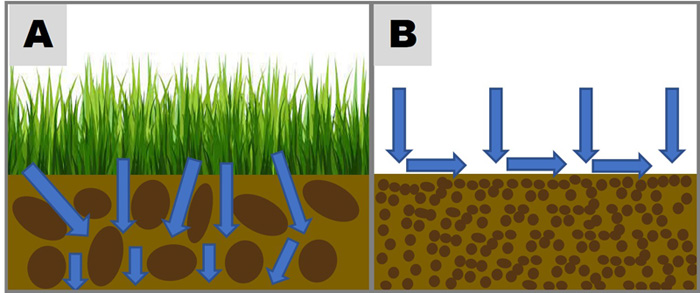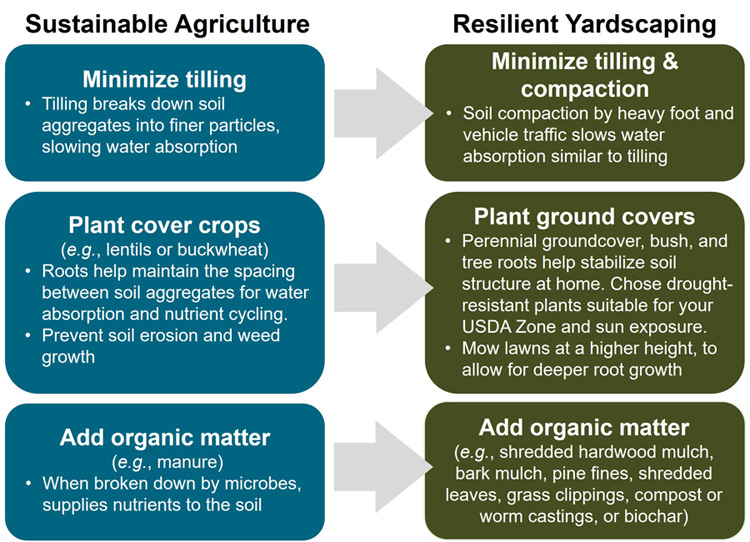Soil Health Learning Resources
Climate Resilience
What are the benefits of healthy soil?
Healthy soil, visually, is dark, soft, and full of large clumps with sizable spacing between them. It is rich with nutrients and contains a wide range of macro- (e.g., soil-dwelling insects) and microorganisms (e.g., bacteria, fungi, protozoa) that support plant health. These organisms have many important functions such as breaking down and mineralizing soil nutrients from organic matter and producing hormones that aid your plants in stress resistance against pests and diseases. The diversity of this soil life is important as many organisms have specialized functions and facilitate different benefits.
Since we are already experiencing more extreme weather events with more intense droughts, flooding, and storms, building resilience at home will become more and more important. Below we list ways in which healthy soil can help your home and garden become more resilient.
Drought resistance. Water is held in the spaces between soil particles. In healthy soils, microbes produce sticky polymers that hold soil particles together and give them some spacing. This allows soil to absorb water more quickly, deeply, and therefore retain it longer. Better-aggregated soils (Figure 1A), have more space to absorb and hold water. Soils with very fine particles (e.g., clay), low amounts of microbial polymers, compacted soils, or soils that have been disturbed by extensive tilling have a harder time absorbing water (Figure 1B). This often leads to soil erosion and urban stormwater runoff of large amounts of water, which carry pollutants such as lawn chemicals and fertilizers into our watersheds from which we draw our drinking water.

Plant health. Soil insects and microbes play a large role in nutrient cycling by breaking down organic matter to make it available for absorption by plants. Healthy soil aggregates with lots of soil life is better able to contain and circulate these nutrients as well as oxygen and water. Better nutrient cycling and soil water absorption protect plants from stress and make them less susceptible to diseases and droughts.
To learn how climate change works and what the effects are, please visit our website: https://as.vanderbilt.edu/gci-ascend/climate-change/
Improving Soil Health
What is organic matter or humus?
To improve soil health, water absorption and retention, and nutrient cycling, we have to support soil life in carrying out their functions. One of the best ways to do that is by creating what is commonly referred to as organic matter.
Organic matter is a large source of carbon-based compounds found within natural and engineered environments. Though present in small amounts, organic matter has a significant impact on soil properties. Agricultural soil contains about 1-6% organic matter by weight.
Organic matter consists of 1) living organisms, 2) fresh residues, and 3) molecules from decomposed residues.
Living Organisms. The living aspect of organic matter represents about 15% of total organic matter and includes microorganisms such as viruses, fungi, and bacteria as well as plant roots, insects, earthworms, and larger animals. These organisms incorporate organic matter into the soil, recycle plant nutrients, stabilize and improve the soil structure, and support water absorption during heavy rains and water retention during droughts.
Fresh Residues (Organic Materials). These consist of recently deceased microorganisms, insects, plant roots, crop residues, and added manures. This organic material is decomposed by living organisms and as a result releases essential nutrients to plants. The organic chemical compounds released during the decomposition also contribute to stabilizing the soil structure.

Humus. Finally, decomposed residues (humus) are further broken down via freezing, thawing, drying, rehydration, and natural tillage, which allows for trapped organic substances to be more accessible to microorganisms to continue to digest humus and make it available to plants.
Humus contributes to soil health by preventing harmful chemicals from causing damage to the environment, making certain nutrients readily available to plants, and by improving water retention in soils. Organic matter is therefore essential to the health and production of soils around the world.
How do I add organic matter to my soil at home?
We know from many years of agricultural research conducted across the world that many effective ways exist to add organic matter to soil and create a more sustainable ecosystem.
For garden beds you can add organic matter by covering beds with shredded hardwood mulch (preferably dye-free), bark mulch, pine fines, shredded leaves, compost or worm castings, or biochar. This not only adds organic matter, but also suppresses weeds, so you don’t have to spray potentially harmful chemicals. You can set up a compost pile at home using a self-constructed bin or readily available Earth Machine composter that keeps food scraps away from wild animals. Metro Nashville even has a video on how to set up an Earth Machine composter. In addition, the Nashville area has local service providers that will pick up your household food scraps in exchange for finished compost such as CompostNashville. At the Tennessee Environmental Council website you can even track your community’s composting success.
For lawns it is very easy to add organic matter by simply using a mulching blade on your mower to shred leaves and grass clippings. Leave the shredded leaves and clippings on the lawn to be reabsorbed instead of removing them. This also saves money by not having to bring in as much lawn fertilizers.
Little Helpers. Ground-foraging, wild mammals can help add organic matter to your soil by working leaf litter and decomposing materials into the soil as they are digging and searching for food in your backyard.

What else can I do improve soil health at home?
Practices that have proven highly successful for farmers can be translated to home yardscaping practices as outlined in Figure 2 below.

Go to the interactive storyboard “How to bring life to dying soils” by the BBC to read more about soil-regenerative agricultural practices.
If you do want to add additional fertilizer to your garden plants and lawn at home, we recommend to 1) always test the soil first so as not to overapply fertilizers, which can harm actually plants and create additional stormwater runoff pollution; and 2) use slow-release fertilizer without added pesticides. Your local county Extension office can quickly give you an exact analysis of your soil at a low cost.
Pest Management
Healthy soils supports more resilient plants because plants experience less stress from nutrient deficiencies or droughts for example. Therefore, establishing healthy soil is the first step to reducing the need to spray your plants against pests and diseases.
Integrated Pest Management is a land management concept applied successfully in agriculture and in urban gardens. It relies on the following principals:
- Prevention and Planning. This includes selecting disease-resistant plant varieties that are suitable for your USDA Plant Hardiness Zone, daily sun exposure pattern, soil type and pH. Prevention can also be achieved by establishing plant diversity as monocultures are more susceptible to spread of a specific disease that can quickly spread in the same plant type. Diverse landscapes also offer a variety of habitat for beneficial insects (“Attracting Beneficial Bugs to Your Garden” by Jessica Walliser) that prey on pests.
Further, barriers or traps can be used to prevent pest problems. For weeds these could be thick layers of mulch that keep light away from weed seeds in the soil, letting your grass choke out other weeds by mowing it taller, or adding netting for vegetable gardens or applying kaolin clay to home fruit trees (“The Holistic Orchard” by Michael Phillips). - Monitoring and Thresholding. Many garden insects are beneficial and prevent pests as prey on pest species and need them for food. To establish a healthy population of beneficial insects, you will want some pests to survive to feed your beneficial insects. Integrated pest management therefore relies on setting action thresholds. The gardener or homeowner will have to learn at which level pests become a serious threat to your plant’s health and intervention is necessary.
- Identification. For successful treatment of a pest it is imperative to first identify it correctly.
- Treatment. This can involve disrupting insect behavior (such as the development of pests or setting up traps), adding barriers (see #1), or applying preferably OMRI-listed sprays or dustings. Apply pest control products only according to instructions, wear proper personal protective equipment, stay away from ditches and streamsides, and apply in the evening to protect pollinators.
Storing Carbon
Carbon Storage in the Ground. As described above, organic matter is a key aspect of healthy soil that plays an important role in its physical, chemical, and biological properties. It improves the quality of soil through retention of water and nutrients, which contributes to the productivity of plants in natural and agricultural environments. In the ground carbon is stored in form of organic matter and in a more permanent form as carbonate when it is mineralized.
Terrestrial ecosystems hold a significant amount of carbon totaling about 3170 gigatons of which almost 80% (2500 gigatons) is stored in the soil. In many areas unsustainable human activity has depleted soil organic matter, which in turn has decreased the productivity of soils and the ability to produce food. In addition, soil degradation through human activity, such as deforestation of rainforests for logging and cheap meat production, has led to an immense release of carbon dioxide into the atmosphere, which was stored in healthy soils and trees.
The release of this carbon to the atmosphere has the a vast impact on global climate, because carbon dioxide is a potent greenhouse gas trapping solar heat inside our atmosphere. About one-third of the total increase in atmospheric carbon dioxide is the result of soil organic carbon release from land-use change, such as deforestation and cultivation of land for agriculture. Depletion of soil organic matter due to soil disturbance has also impacted infiltration of rainfall and storage of soil moisture as well as increased erosion and nutrient leaching from soils.
Read this article on “Soil as a Carbon Storehouse: Weapon in Climate Fight?” published by Yale’s School of the Environment to learn more of soil’s potential of sequestering and storing carbon.
Carbon Storage Above Ground. To store additional carbon above ground, we can plant more vegetation in our yards. Trees not only store lots of carbon but also provide cooling shade, especially in urban areas that are becoming heat islands as an effect of climate change. Ground covers help shade plant roots and soils, provide soil structure and prevent soil erosion. In this way some local farmers go out of their way to “farm carbon” while producing nourishing food.
